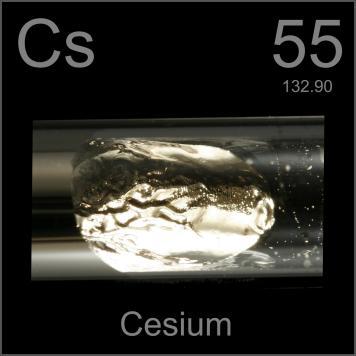|
|
The metal is characterised by a spectrum containing two bright lines in the blue (accounting for its name). It is silvery gold, soft, and ductile. It is the most electropositive and most alkaline element. Cesium, gallium, and mercury are the only three metals that are liquid at or around room temperature. Cesium reacts explosively with cold water, and reacts with ice at temperatures above -116°C. Cesium hydroxide is a strong base and attacks glass. Cesium reacts with the halogens to form a fluoride, chloride, bromide, and iodide. Cesium metal oxidized rapidly when exposed to the air and can form the dangerous superoxide on its surface. Applications Cesium is used in industry as a catalyst promoter, boosting the performance of other metal oxides in the capacity and for the hydrogenation of organic compounds. Cesium nitrate is used to make optical glasses. Cesium is sometimes used to remove traces of oxygen from the vacuum tubes and from light bulbs. Cesium salts are used to strenght various types of glass. The chloride is used in photoelectric cells, in optical instruments, and in increasing the sensitivity of electron tubes. Cesium is used in atomic clocks and more recently in ion propulsion systems. |
